#rural cultural preservation
Explore tagged Tumblr posts
Text
Jharkhand MLA Sukhram Oraon Attends Chhau Dance Event in Hijia Village
Sukhram Oraon pledges support for traditional art form at annual cultural gathering Chakradharpur legislator emphasizes importance of preserving and promoting local dance heritage. CHAKRADHARPUR – Chakradharpur MLA Sukhram Oraon graced a Chhau dance performance as the chief guest in Hijia village of Baipi Panchayat on Wednesday. The annual Chhau dance program in Hijia village drew enthusiastic…

View On WordPress
#राज्य#Baipi Panchayat events#Chakradharpur Chhau dance event#Chakradharpur constituency cultural initiatives#Hijia village annual festival#indigenous art forms Jharkhand#Jharkhand Mukti Morcha youth engagement#Jharkhand traditional arts promotion#local community celebrations#MLA Sukhram Oraon cultural support#rural cultural preservation#state
0 notes
Text
I suppose I never shared on here but I actually have a second Bully OC, in addition to Lorein "Loopy" Stimson. His name is Atticus, and he's a prep, but he's not a local Bullworth heritage family. Instead, he fancies himself a southern dandy... (He's from Virginia. In true prep fashion, he does not need to talk Like That.)
#bully oc#bully#not gonna put most of the main tags bc this is basically a nothing post... unless someone's interested in hearing about him?#lorein was made up of a lot of my own high school experience#atticus is there to fill in the gaps#bc my high school was given multi-million dollar grants from a local yet internationally known company#which was historically owned by one family whose preserved houses are part of the local tourism but I always wanted to live in one growing#lot of weird history and strange rural/corporate culture in the town i went to school in#combine that with my growing dandyism as I finally started coming into my own my last two years of high school#you get Atticus W. Pruden
3 notes
·
View notes
Text
Supporting Local Vendors This Diwali: An Economic Perspective
Diwali, the festival of lights, is not just a time for celebration; it is also an opportunity to bolster local economies and support small businesses. As we prepare for this festive season, it is crucial to understand how supporting local vendors can significantly contribute to economic resilience, cultural preservation, and community well-being....click here to read more
#Supporting Local Vendors#local vendors Diwali support#Support small businesses#community economy#cultural preservation#buy local to boost rural economy#economic impact of Diwali#Insightful take on Diwali#support local business to celebrate brighter diwali#by local for rural economy.
1 note
·
View note
Text
Discovering Bhutan: The Last Shangri-La
Nestled in the Eastern Himalayas, Bhutan, known as the “Land of the Thunder Dragon,” is a country that beckons travelers with its pristine landscapes, vibrant culture, and profound spirituality. As one of the world’s last remaining Buddhist kingdoms, Bhutan offers a unique blend of ancient traditions and modern sensibilities. In this travel guide, we’ll explore Bhutan’s history, political…

View On WordPress
#" is a country that beckons travelers with its pristine landscapes#adventure#africa#all international tourists (excluding Indian#all international tourists need a visa arranged through a licensed tour operator#and a guide#and a guide. This policy helps manage tourism sustainably and preserves the country&039;s unique culture. Currency and Bank Cards The offic#and archery. Safety Bhutan is one of the safest countries for travelers. Violent crime is rare#and Buddha Dordenma statue. Punakha: Known for the majestic Punakha Dzong#and cultural insights to help you plan an unforgettable journey. Brief History of Bhutan Bhutan&039;s history is deeply intertwined with Bu#and Culture Religion: Buddhism is the predominant religion#and experiencing a traditional Bhutanese meal are top cultural activities. Is it safe to travel alone in Bhutan? Bhutan is very safe for sol#and Kathmandu. Infrastructure and Roads Bhutan&039;s infrastructure is developing#and Maldivian passport holders) must obtain a visa through a licensed Bhutanese tour operator. A daily tariff is imposed#and red rice. Meals are typically spicy and incorporate locally sourced ingredients. Culture: Bhutanese culture is characterized by its emph#and respectful clothing for visiting religious sites. Bhutan remains a land of mystery and magic#and stupas are common sights. Food: Bhutanese cuisine features dishes like Ema Datshi (chili cheese)#and the locals are known for their hospitality. However#and vibrant festivals. Handicrafts#Bangladeshi#Bhutan#Bhutan offers a unique blend of ancient traditions and modern sensibilities. In this travel guide#Bhutan promises an experience unlike any other. Plan your journey carefully#Bhutan was never colonized. The country signed the Treaty of Sinchula with British India in 1865#but English is widely spoken and used in education and government. What should I pack for a trip to Bhutan? Pack layers for varying temperat#but it covers most expenses#but it&039;s advisable to carry cash when traveling to remote regions. Top Places to Visit in Bhutan Paro Valley: Home to the iconic Paro T#but it&039;s advisable to carry cash when traveling to rural regions. What are the top cultural experiences in Bhutan? Attending a Tshechu#but they offer stunning views. Religion#comfortable walking shoes
0 notes
Text

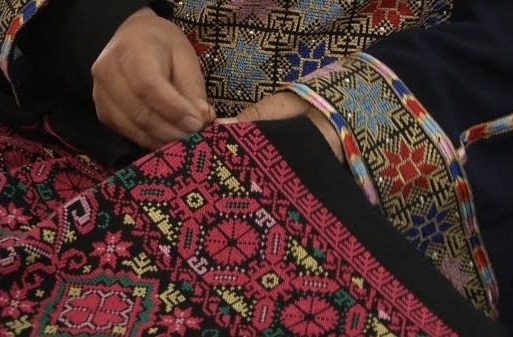

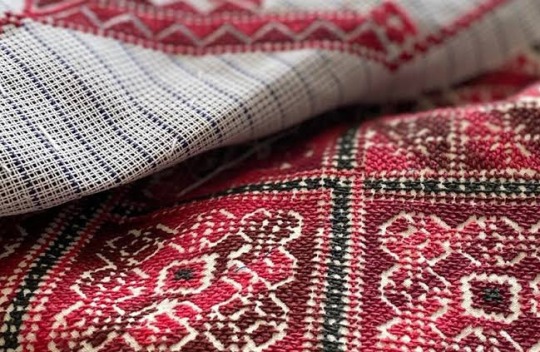
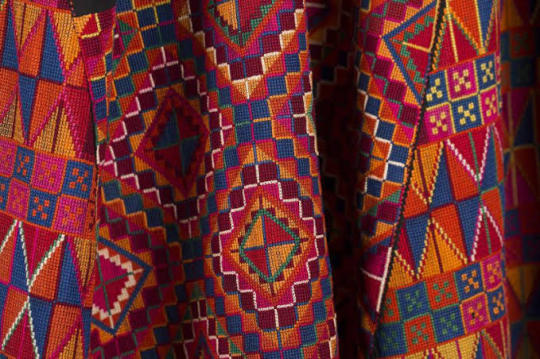

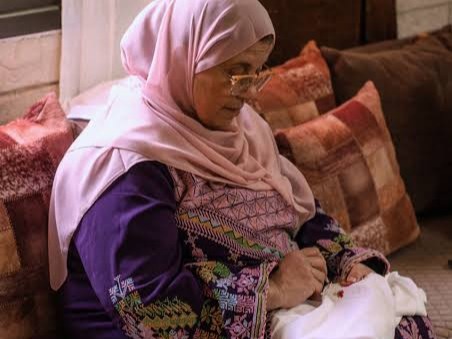

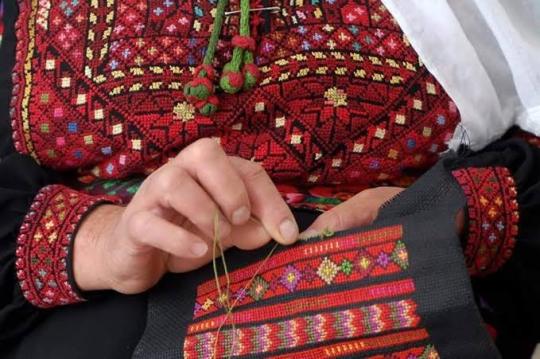

Tatreez (Arabic: تطريز) is a type of traditional Palestinian embroidery. Tatreez uses traditional cross-stitch embroidery and is practiced largely among women. The craft was originally practiced in rural areas of Palestine, but is now common across the Palestinian diaspora. Historically, each village in Palestine had their own tatreez patterns. The landscape was a major source of inspiration for the patterns and motifs, which speaks to the variation in style that was common to see among all of the different tatreez expressions that were particular to each Palestinian village.
After the violent displacement and dispossession of Palestinians in 1948, people were living together in refugee camps. The different styles of tatreez became less distinct and have continued to evolve with the diaspora. Following 1948, tatreez evolved to reflect the experiences of Palestinians. Palestinian women began to incorporate the Palestinian flag and its colors into their tatreez as a means of resistance to the occupation of Palestine. Consequently, tatreez became an expression of the identity, heritage and resistance of Palestinian women and their dedication to preserve their ancient culture.
1 / 2 / 3 / 4 / 5 / 6 / 7 / 8 / 9 / 10 / 11 | textile series
#textiles#ots#tatreez#palestine#palestinian art#palestinian culture#free palestine#from the river to the sea palestine will be free#embroidery#textile art#middle east#levant#levantine#fashion
14K notes
·
View notes
Text
I feel very defensive about the "goth is bougie" shit because it is historically incorrect, yes, but also and more personally, because it just erases the generations of goth kids who grew up in trailer parks and project housing or just straight up homeless, helping each other out.
it's specifically such a supportive subculture for poor and neglected kids and I really fucking hate that this has been revised and erased. juggalos and goths are very culturally close and many subcultural people are both, and juggalos have the same (and, I would argue, even better defined) culture of collective support. the Skids in Letterkenny are not made up for the show, that's just a real type of rural subcultural person. this has also been forgotten in the interim but in the 90s and 00s we didn't even really refer to OURSELVES as "goths" very much except in a joking way. goths had regional endonyms (like "skids" or "trenchies") even if they could all go to a convention or a club in a city and in that context be all called "goths" together, once they went back home they would go back to being whatever the locals called them or whatever they called themselves. this is a whole linguistics and sociology subtopic that's out of scope for a Tumblr post but is sort of related.
my point is that people who wore actual rags, and sharpie instead of nail polish, and wet n wild eyeliner instead of black lipstick, and dyed their hair with markers or food coloring or kool-aid, were and are the core of the goth scene. the majority of the pictures the mallgoth blogs are posting are from catalogs, fashion shows, costume events, yearly balls and fetes like Wave Gothik Treffen, and other places where people save up literally all year, or many years in a row, to put together ONE outfit. and there's nothing wrong with that, personally I'm proud and pleased that our hard work is being recognized and preserved. but just like formal studio photographs from the Victorian era, it is not representative of the daily or even weekly (for clubs) reality of people in the scene, some of whom were completely out of goth clothing during the day or week just to fit in at work or sometimes just to get along without being bothered at home by family members who thought the Cure was Satanic.
the people who RUN the scenes, the promoters and DJs and gogo dancers and independent designers and people who run the mailing lists and websites, the people who organize the room parties at conventions, and yes even most of the original Burning Man camps like Thunderdome, they mostly live in poverty. especially if they're young. when people organize club nights and shows, they're lucky if they break even. I wasn't aware of any of this until I started working at DNA Lounge in San Francisco, which hosts one of the oldest goth nights in the country, Death Guild. I got to know the owner of DNA well enough to find out about the financial reality of the entire scene, even the people who own the means of production and the actual property in this case, and it's not lucrative. I mean, it sometimes is, if you're running a bar for normal people and have investment captain etc, but the majority of legit subculture economics is just barely breaking even. every single event is 90% volunteer labor.
the issue of labor is maybe the confusing thing for the zoomers who are confused. goth outfits take actual physical work. maybe the Aspirational Spectacle of Labor that makes up most of TikTok has made it appear unreal to the audience rather than something you can just sit down and do?
it takes forty seconds to make the fishnet tights into a shirt. you don't need instructions, you really can just look at it and figure it out. then you think, hm, if I can make fishnets into a shirt I wonder what other things I can turn into something else. your brain will amaze you. my mom would save her tights from her formal work outfits for me when they got holes or whatever and I would just go crazy with scissors and safety pins. lots of young designers are getting attention for this layered, tights-n-pins look at the moment and it really is a fantastic aesthetic but I wonder if people think there's something special about the people who make these clothes? there isn't. you can just do it at home while you watch trashy youtubes.
one time, around 2008 or so, @gothiccharmschool and I were at the photoshoot for tabletop RPG Unhallowed Metropolis. we were there with a bunch of local goths to all make the pictures for this book together. we had all brought tons of our costumes from home to cobble together outfits for the book illustrations, and there was a moment when I just handed Jilli a pile of black skirts and some pins and said hey Jilli, could you please make me up a bustle skirt for this model real quick while I shoot these other models? and of course she did, and they were beautiful, because she knows exactly what she's doing, and because that's all a bustle is: it's a way of bunching up a skirt with another skirt. you can do it at home. you don't need instructions or to hire a seamstress or watch a video. you can just look at something and say hm does it look like a bustle? let's drape it and play with it and pin whatever works. and then you wear it for the photoshoot, or to the club!!! and then next week you pin it a different way and it's a cape instead and you wear it again!!!!!!!
3K notes
·
View notes
Text
Travel the World of Imagination: Journeys Beyond Border
Kieth Denmark M. Retes | BSIT1A OVERVIEW:
Switzerland originates from the Old Swiss Confederacy established��in the Late Middle Ages, following a series of military successes against Austria and Burgundy; the Federal Charter of 1291 is considered the country's founding document. Swiss independence from the Holy Roman Empire was formally recognized in the Peace of Westphalia in 1648. Switzerland has maintained a policy of armed neutrality since the 16th century and has not fought an international war since 1815. It joined the United Nations only in 2002 but pursues an active foreign policy that includes frequent involvement in peace building.
Switzerland is the birthplace of the Red Cross and hosts the headquarters or offices of most major international institutions including the WTO, the WHO, the ILO, FIFA, the WEF, and the UN. It is a founding member of the European Free Trade Association (EFTA), but not part of the European Union (EU), the European Economic Area, or the eurozone; however, it participates in the European single market and the Schengen Area. Switzerland is a federal republic composed of 26 cantons, with federal authorities based in Bern. references: Switzerland - Wikipedia
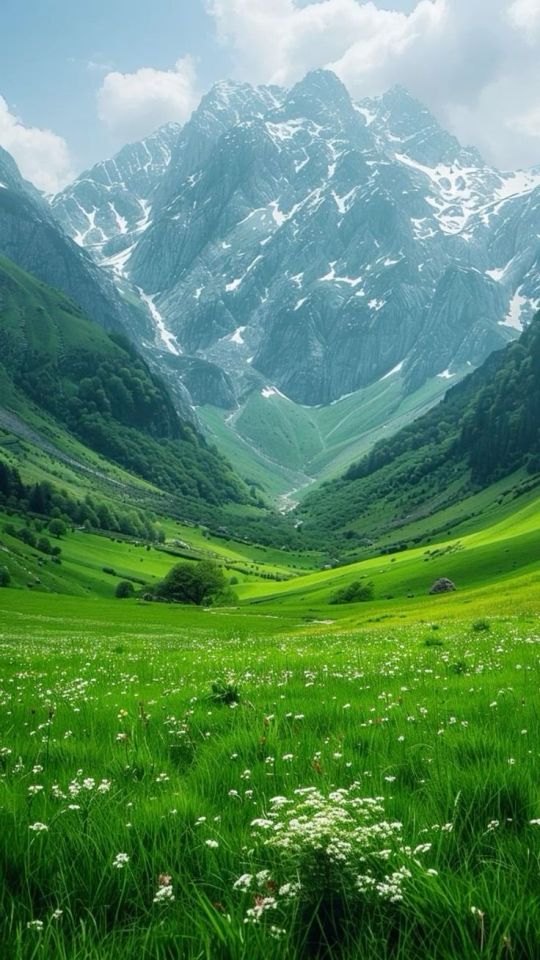
Switzerland, a small yet influential country nestled in the heart of Europe, stands out in many ways. From its awe-inspiring landscapes to its unique political system, Switzerland offers a blend of natural beauty, cultural diversity, and global diplomacy that few other nations can match. Its distinct character is a product of centuries of neutrality, innovation, and a deep respect for its heritage, all of which contribute to the nation’s unparalleled reputation on the world stage.
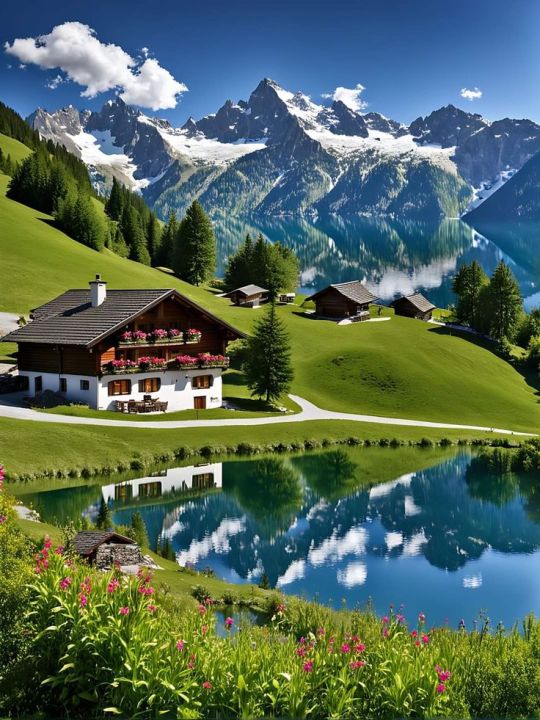
One of the first things that captivates visitors to Switzerland is its breathtaking scenery. The country is dominated by the majestic Alps, with towering snow-capped peaks that attract adventurers and nature lovers from around the globe. Whether it’s skiing in world-class resorts like Zermatt and St. Moritz or hiking through verdant valleys and along crystal-clear lakes, Switzerland offers outdoor experiences that are hard to rival. Beyond the Alps, the country is dotted with picturesque towns, lush meadows, and sparkling lakes, such as Lake Geneva and Lake Lucerne, each offering their own unique charm. The country's commitment to environmental preservation further enhances the beauty of these landscapes, ensuring that they remain pristine for future generations.
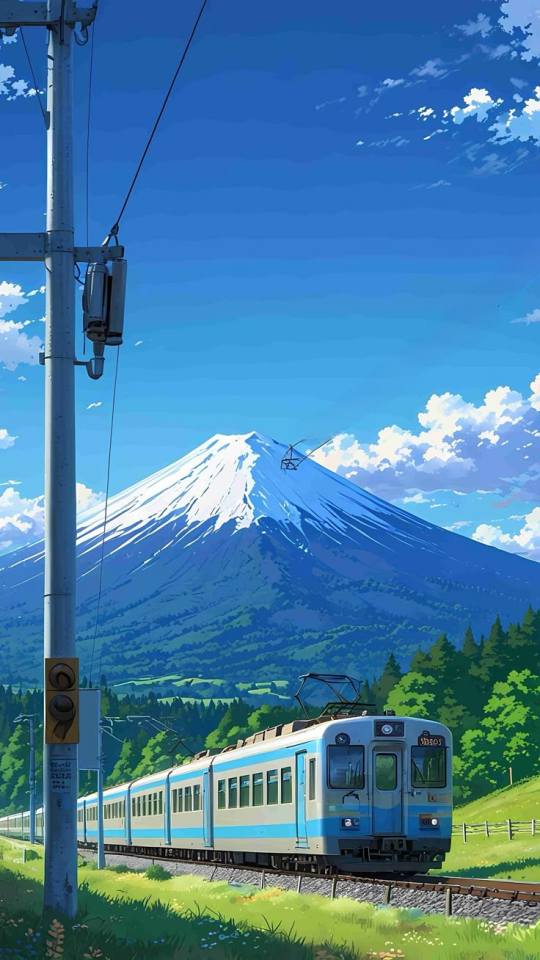
Swiss culture is characterized by diversity, which is reflected in diverse traditional customs. A region may be in some ways culturally connected to the neighbouring country that shares its language, all rooted in western European culture. The linguistically isolated Romansh culture in Graubünden in eastern Switzerland constitutes an exception. It survives only in the upper valleys of the Rhine and the Inn and strives to maintain its rare linguistic tradition.
Switzerland is home to notable contributors to literature, art, architecture, music and sciences. In addition, the country attracted creatives during times of unrest or war. Some 1000 museums are found in the country.
Among the most important cultural performances held annually are the Paléo Festival, Lucerne Festival, the Montreux Jazz Festival, the Locarno International Film Festival and Art Basel.
Alpine symbolism played an essential role in shaping Swiss history and the Swiss national identity. Many alpine areas and ski resorts attract visitors for winter sports as well as hiking and mountain biking in summer. The quieter seasons are spring and autumn. A traditional pastoral culture predominates in many areas, and small farms are omnipresent in rural areas. Folk art is nurtured in organisations across the country. Switzerland most directly in appears in music, dance, poetry, wood carving, and embroidery. The alphorn, a trumpet-like musical instrument made of wood has joined yodeling and the accordion as epitomes of traditional Swiss music.
references: Switzerland - Wikipedia
64 notes
·
View notes
Text
Since there’s a bit of a hiatus in Dracula Daily right now, I thought I’d take the opportunity to ramble about what I know of vampiric folklore and history in Europe because I cannot contain my infodump and it’s actually really interesting.
Painting it in very broad strokes, the earliest folkloric creature we would recognize as a vampire was acknowledged in Europe in the 1100s and earlier as a human corpse that physically rose from their grave and returned to their former home/village to drink blood. (A 12th-century English text, The Life and Miracles of St. Modwenna, mentions two examples of this type of vampire.) These vampires’ victims did not become vampires as well, but sickened and died, usually from wasting diseases. What caused the original person to become a vampire was variable, but usually involved being, just, an absolute jerk when they were alive, or an increasingly convoluted series of ways in which they attracted bad luck/evil while they lived, after they died, or as they were buried.
This is where the traditions of stuffing a stone in the potential vampire’s mouth, decapitating them and putting the head in the grave between their knees, burying them facedown, cutting off their hands or feet, burying them in a too-small grave, piling stones atop the grave, or burying them with broken legs came from. All of these are regional or historical variations on ways to quite literally prevent the presumed vampire from digging their way out of the grave and causing trouble: an “And stay down there!” maneuver that we’ll see survive into modern pop culture in the form of a stake through the heart.
This was the predominant form of vampirism up until roughly the 1700s: someone nasty in the village died, and after a while, would start reappearing to their family or loved ones at night, slowly draining their lives away as they fell to a wasting disease like tuberculosis or leprosy. Once the villagers caught on, they would exhume the body, find it suspiciously preserved and with blood trickling from its mouth, and then take steps to neutralize the vampiric threat by beheading, staking it through the heart to literally pin it in the grave, stuff a stone in its mouth, or a combination of all three.
(You may have heard of the Venetian mass-burial plague pit an archeological team discovered: one of the skeletons had a brick shoved in her mouth. She was the only body treated in such a way, implying that she was thought to have been a vampire: hypothetically even the vampire that caused this local upswing of the plague.)
A cultural shift happened in the 18th century, however, when the Austro-Hungarian Empire gained territory in Serbia and other portions of the Balkans. Since they were neighbors with the Ottoman Empire, the Austro-Hungarians kept a heavy military presence in these new territories, and the emperor of the time (Charles VI, I believe) asked the occupying forces to collect reports on the local customs and folklore and send them back.
A number of the reports they sent back included vampire stories.
Now, this was the Age of Enlightenment: many countries were pulling away from old superstitions and following the new methods of science. Belief in vampirism was a rural thing, and widespread plague situations had faded enough that they really weren’t relevant anymore and had fallen out of a lot of people’s memory.
But the thing was... science was still new, and this whole vampirism thing sounded just plausible enough to be extremely interesting. The Austro-Hungarians sent all sorts of scientists, doctors, and clergy members to collect and dissect and discuss these stories, and for a short spate of time vampirism was the hot new discussion topic in esoteric circles. And for then and a while after, if you wanted case studies, debates, and just about any reference material on vampires, you knew you’d find it in Austro-Hungary’s library.
Eventually the scientific community all concluded that this vampirism thing was just silly peasants not understanding the process of decay, but the arts crowd -particularly the Sturm und Drang folks in Germany- remained very interested in this exotic new creature steeped in mystery and death. Sturm und Drang translates to “storm and stress” and if I had to describe their style in modern terms, I would say (roughly, and with affection) “a love of edgy tragedies.”
There were a number of poems and works spawned from this flurry of interest, but this Austrian version of the vampire still shared a common theme: more like a revenant than anything else, coming for their loved ones first, and a lot of their horror was tied up in how blasphemous and unChristian their very existence was. Less emphasis was placed on getting rid of the vampire and more was placed on the artistic allure of vengeance from beyond the grave and the vampire’s inherent exotic mysticism and threat.
Stoker, in fact, directly references an example of this in Dracula! On May 5th, when Dracula’s telling the coach driver that he knew they were trying to get Jonathan out of there before he showed up, because he himself drove fast enough to intercept them, one of the other passengers whispers to his friend “Denn die Todten reiten schnell,” which translates roughly to “For the dead ride fast,” a quote from Burger’s Lenore.
Lenore is a poem about a young woman whose fiancé died in the Seven Years’ War (connection with Austro-Hungary). In her despair, she curses god (old-school invitation for vampirism), and the following night, her lover knocks on her door to take her on horseback to their marriage bed (vampires attack their loved ones first). He takes her on an increasingly terrifying ride through the night, prompting the above quote, which ends in a graveyard, where he is revealed to be a skeleton and Lenore dies.
Lenore was written in 1774, and although William is not technically a vampire, the poem is an example of the old-school vampire type. The vampire is a physical reanimated corpse that does not create more of its kind, but causes the people around them to die/waste away, and attacks their loved ones before anyone else. The transition to what we finally would recognize as a modern vampire started with Carmilla and was solidified in Dracula.
Written in 1872, Carmilla is a blending of both old and modern vampiric tropes. It uses the then-expected setting of the Austrian Empire, all of the titular vampire’s victims wasted away and died rather than rising as vampires themselves, and Carmilla’s coffin was filled with blood when she was unearthed. However, she was also able to shapeshift into a cat and walk through walls -no longer just a revenant- and she could walk around during the day without harm. She also does not target the people she knew and loved in life first: Carmilla is a vampire centuries old and her current victims are chosen indiscriminately. The vampire as a folkloric creature was evolving.
And, side note, while it was used partially as a narrative device to show how evil and unnatural Carmilla was, she was also gay. Gay as fuck. People who lost their shit at
“Then the Count turned, after looking at my face attentively, and said in a soft whisper: ‘Yes, I too can love’”
will go absolutely mental at Laura going
“It was like the ardour of a lover; it embarrassed me; it was hateful and yet overpowering; and with gloating eyes she drew me to her, and her hot lips travelled along my cheek in kisses; and she would whisper, almost in sobs, ‘You are mine, you shall be mine, and you and I are one for ever.’"
Anyway. Queerness is baked into the concept of the modern vampire from the very beginning, what of it.
With Carmilla as the springboard, though, Stoker was free to finally create Dracula, which was essentially the turning point between modern and archaic vampire depictions. He took all of the old stuff and reworked, revamped (heh), or added to it to get the foundation of the stereotypical vampire we know today.
He shifted the geographic vampire hotspot further over from Austria-Hungary, landing it in neighboring Transylvania. Dracula’s victims weaken and die and seem to be inflicted with a strange wasting disease, but can also turn into vampires themselves. Driving a stake through his heart and cutting off his head is no longer an attempt to pin him in his grave and keep him from rising, but merely to destroy him. He was dead, yes, and very unholy, but he also had powers beyond merely being a risen corpse, and his power set became the standard for future vampire media.
Hence, Dracula becomes the foundation for the modern concept of a vampire, which is why pop culture usually treats it as the beginning point of vampirism in general.
819 notes
·
View notes
Text
If you're from Argentina, you've probably heard about the Iberá wetlands, and you know the tourist pitch: a vast expanse of natural wonders in the middle of Corrientes, full of beautiful lapachos, cute carpinchos and yacarés, and now home to the fastest-growing wild yaguareté population, all with the unique Guaraní influenced culture of rural Corrientes.
Now, things aren't as shiny as they look, since the creation and management of the new national park is still a point of contention in many ways, but you will be suprised that this kind of thinking about the Iberá is very, very recent. Most people considered it an obstacle to progress, a big bunch of swamp in the middle of what could be a very productive ranching province. In a geography book from the 1910s (unfortunately I lost the screencap) it says something like "the biggest obstacle for the development of the province is this swamp, and it should be drained"
This took me to the other side of the world, to the Netherlands. They're known for land reclamation, from literally building their country from the sea. Especially when we're facing rising sea levels because of climate change, the Dutch seem like miracle workers, a look into our future. You will find no shortage of praise about how with some windmills and dams, the Dutch took land "from the sea", and turned it into quaint little polders, making a tiny country in Europe a food exporter and don't they look so nice? But when you look about it, you can barely find anything about what came before those polders. You have to dig and dig to find any mentions of not "sea", but of complex tidal marshes and wetlands, things I've learned are ecologically diverse and protected in many places, but you won't find people talking about that at all when talking about the Netherlands. It's all just polders now. What came before was useless swamp, or a sea to be triumphantly conquered. It's like they were erased from history
The use of that language reminded me of the failed vision of draining Iberá... and the triumphing vision in the Netherlands, and many other places. Maybe those wonderful places, those unique wetlands, would have been a footnote, you wouldn't find anything unless you were a bored ecologist who looked, and not even then. Now, far it be from me to accuse the medieval Dutch, who wanted to have more space to farm, of ecocide. And don't think this is going to be a rant against European ecological imperialism either, as the most anthropized places you can find are actually in China and India. But it does get me thinking.
I work with the concept of landscape, and landscape managing. (Not landscaping, those guys get better paid than me) The concept of landscape is somewhat similar to the concept of ecosystem you know from basic biology, but besides biotic and abiotic factors, you also have to involve cultural factors, that is, humans. There is not a single area of "pristine" untouched nature in the world, that is a myth. Humans have managed these landscapes for as long as they have lived in them. The Amazon, what many people think about when they think about "unspoilt" nature, has a high proportion of domesticated plants growing on it, which were and are still used by the people who live on it, and there once were great civilizations thriving on it. Forests and gardens leave their mark, so much that we can use them to find abandoned settlements. From hunter-gatherers tending and preserving the species vital to their survival in the tundra to engineers in Hong-Kong creating new islands for airports, every human culture has managed their natural resources, creating a landscape.
And this means these landscapes we enjoy are not natural creations. They are affected by natural enviroments; biomes do exist, species have a natural distribution. But they are created and managed by humans. Humans who decide what is valuable to them and what is not. The Dutch, seemingly, found the tidal marshes useless, and they created a new landscape, which changed the history of their nation forever. We here in modern Argentina changed our perception of Iberá, decided to take another approach, and now we made it a cherished part of our heritage, which will also speak about us in the future.
Ultimately, what is a useless swamp to be drained or a beautiful expanse of nature to be cherished depends in our culture, in us humans. We are the ones who manage and change ecosystems based in our economics, our culture, our society. This will become increasingly important, as climate change and ecological degradation becomes harsher and undeniable. We will have to decide what nature is worth to us. Think about what is it worth to you.
#I REALLY had to restrain myself not to make a football joke about the netherlands#cosas mias#ecology#biology#culture#cultural landscapes
163 notes
·
View notes
Note
Apologies if you've answered this somewhere: for your Amaranthine 'verse, are there any "hybrid" animal folk? On one hand, kwillow's Theo has a rat and a stoat as parents, but Theo himself is a rat (with his mother's coloring, but still a rat). On the other, Ambroys very clearly looks like a cross between a horse (father) and Something Else (Celestial mother). In the middle is Hayden's one night stand with the cat barmaid, which resulted in a child with a bunny's snout/tail, a flatter catlike face, and bunny ears a biiiit too wide and pointed to be 100% "bunny."
I'm super curious about the genetics of it as well as the social aspect (i.e. is son considered a bunny/cat/both by his peers?). It's one of my favorite bits about anthro worldbuilding!
Hybrids exist, but are pretty rare!
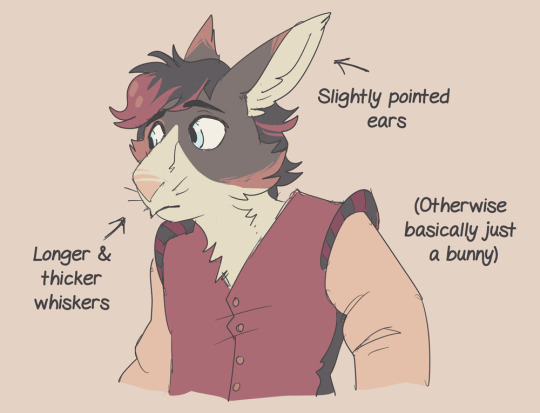
Typically, children will just inherit their species from one parent or the other. Hybridization is very unusual and typically is limited to one or two very minor traits--like the child of a rabbit having slightly longer ears, the child of a weasel having a noodlier build, the child of a carnivore having fangs, etc. In almost all cases, the dominant species of the child is very clear, and the hybrid traits tend to be very recessive--rarely preserved beyond one generation.
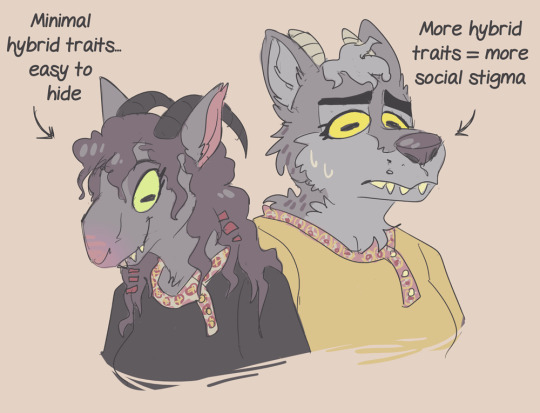
Particularly in the Western Kingdom, though, hybrid children do have a reputation for being unlucky, an ill omen, or even outright cursed (depending how superstitious the person you're asking is). There are a few reasons for this… the simplest is that hybrid traits are sort of a "birth defect" that can sometimes present along with other health issues. Though not all hybrids are frail and sickly, any concern about a child's susceptibility to illness was a huge deal in rural peasant villages that already tended to have high childhood mortality rates.
Over time, the perception of hybrid children = ill omen became warped and exaggerated. Western Kingdom folktales sometimes cast hybrids as vaguely supernatural trickster characters, such as tales of mysterious changeling babies whose hybrid traits eventually revealed them to be half Infernal.
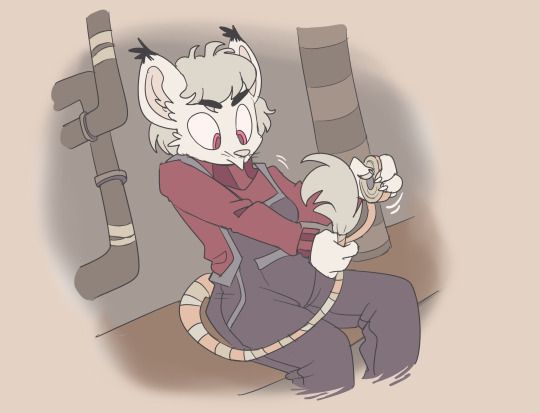
For this reason, the actual frequency of hybrid traits is probably greatly under reported… anyone who can hide or ignore or lie about their hybrid traits probably will. Though most Western Kingdom superstitions fell away after the collapse of the old kingdoms, some degree of stigma in Post-Fall society remains. No one seriously thinks a sheep with fangs is half Infernal anymore (most don't believe that Infernals and Celestials even exist), but it will still probably be passively assumed that a hybrid is less fit for difficult labor, among other things.
Half Celestial and Half Infernal offspring work a bit different… they're always technically "hybrids", but specifically hybridize in such a way that they take the form of mythological creatures (unicorn, dragon, cockatrice, etc). I'll let Kwillow talk more about this when she discusses Ambroys' mother since she's been the one working on this section of the lore, but Half Celestials are most certainly seen as a blessing. Half Infernals… well, fear of them is part of the reason hybrids are stigmatized in the first place, so suffice to say they have it rather rough. How severe the stigma is varies across cultures and tends to be worse in the rural West, better in cities, and pretty much completely absent in much of the Eastern Kingdom.
In the Post-Fall present day, nobody believes Celestials, Infernals, or their offspring exist anymore... aside from those who know about The Kingdom of the Sun.
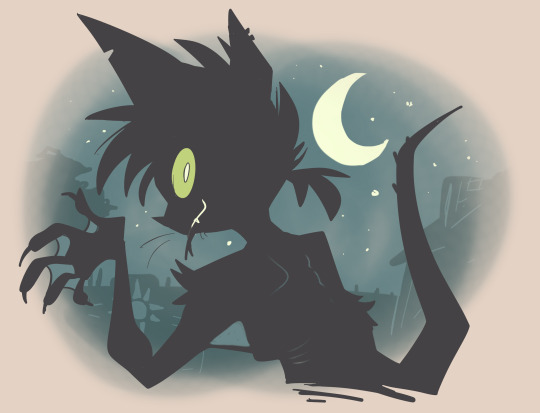
Also, once in a while, a hybrid is born whose traits are so blended that their parent species are difficult to determine. These very unlucky individuals are referred to as "chimeras" and tend to have shorter life expectancies, among other things. We may be seeing a character who fits this description eventually. :P
#I wrote up a whole thing for this and then Tumblr deleted it and I was so annoyed it took another month before I felt like rewriting it#I still think the old version that Tumblr bugged out and erased was better#ah well#furry#worldbuilding#furry worldbuilding#verse: amaranthine#wow the new post editor really doesn't play nice with read more does it
226 notes
·
View notes
Note
Recently watched some kinda documentary, more like short docu-vid abt a town that burnt down some thousand+ of years ago, and the only thing that showed that the town existed was some tiny pottery shards that got preserved all over what ppl assume used to be the town. Nothing special, just some lil town in the middle of what's basically rural nowhere. And like, the reason that's the only thing left was bc the entire town was probably built completely out of lumber, straw or some other flammable material and went up in flames. And I'm kinda like, damn how many towns and civilisations built from stuff like lumber existed but just got burnt down? Accident or in warfare? Lots of war stuff would have ppl burning down places to weaken the enemy or to place your own stuff on top, Scandinavia today seems to be like 80% lumber in rural areas. I know that some pre-Christian cultures and religions got destroyed, assimilated and burnt down in Europe, and the same with Pre-Islam cultures got destroyed by invaders. How much shit is gone just bc it was easy to burn, or otherwise destroyed or assimilated? Like, I know ppl talk abt all that shit, but so much has like a historical scar you can look at, but what abt those that didn't even leave a scar?
--
But nonnie, postholes!
Archeology is really cool, and we actually can spot all-wood things in many cases, even if they did get burned down and/or rot away centuries ago. In fact, if they were burned down, they're sometimes easier to spot.
59 notes
·
View notes
Text
Excerpt from this story from The Desert Sun:
All of America's national monuments must be reviewed for potential oil and gas drilling and mining reserves, critics say, per bureaucratic language tucked deep in a sweeping order issued on Monday by newly sworn-in Interior Secretary Doug Burgum.
His order 3418, “Unleashing American Energy,” mandates that the Interior Department finish its initial monument review by Feb. 18.
That means 157 locations in 33 states and several national territories — including the freshly designated Chuckwalla National Monument and Sattitla National Monument in California — could be subjected to the expedited 15-day review, and attempts could be made to "revise" their boundaries.
Monuments protect cultural and historic resources and the lands that contain them, and are created by Congress or U.S. presidents. California has more monuments than any other state, with more than 4 million acres likely under review, one expert said, from popular desert off-roading trails to massive coastal redwoods. They include Mojave Trails, Sand to Snow, Carrizo Plain, Muir Woods, Devils Postpile, Cabrillo, Lava Beds, California Coastal, Sequoia NF, Cesar Chavez, Fort Ord, San Gabriel Mountains, Berryessa Snow Mountain and Castle Mountains.
The relevant portion of Burgrum's order includes “actions to review and, as appropriate, revise all withdrawn public lands, consistent with existing law, including 54 U.S.C. 320301 and 43 U.S.C. 1714."
Although not spelled out in plain English, those sections of code govern the Antiquities Act of 1906, under which 20 U.S. presidents have set aside millions acres of land and historic sites, from Alaska to Florida.
[Additional information from a story from Inside Climate News:
The order calls on the Interior’s assistant secretaries to identify in their action plans how to accomplish “actions to review and, as appropriate, revise all withdrawn public lands” under the Antiquities Act of 1906, the law that allows presidents to create national monuments, and the Federal Land Policy and Management Act of 1976, which outlines how federal lands can be used and allows for the establishment of national wildlife refuges and more. ]
Many Republican lawmakers have criticized presidents' use of the Antiquities Act to block mining, fossil fuels and other industrial development on federal monument lands.
But myriad environmental, hunting and fishing groups sharply condemned Burgum's actions, once the meaning became clear.
"Burgum knows that attacking monuments is incredibly unpopular, which is why he won't even use the words 'national monuments' or 'Antiquities Act' in his orders. He's trying to operate in secret here, and definitely does not want any public input," said Aaron Weiss, deputy director of Center for Western Priorities.
"This is a sneaky, unpatriotic attack that strikes at the very foundation of the country’s beloved public lands," a coalition of groups said in a news release condemning the order. "These national treasures are broadly beloved. They safeguard our water, buoy the outdoor recreation economy, protect our trails, and preserve a national heritage rich in culture and natural beauty. Attacks on the outdoors, such as this order from Secretary Burgum, threaten the $640-billion recreation economy, putting millions of jobs at risk."
The statement added that "the order fails to recognize that oil production hit record highs under the Biden administration. This isn’t about energy dominance. Washington politicians and their billionaire advisors have an unpatriotic anti-public lands agenda that aims to dismantle our national monuments for corporate polluters."
And here's a statement from the Conservation Lands Foundation:
These orders also willfully ignore the rural residents and communities whose personal and local incomes rely on these lands being protected from privatization. Outdoor recreation on BLM lands contributes more than $11 billion to the economy and substantial income to individuals, small and large businesses, and rural communities through hunting, fishing, camping, climbing, riding off-highway vehicles, and many other activities.
With roughly 85% of BLM lands already available for energy production–and roughly half of existing oil and gas leases not being used–it's crystal clear that these recent orders targeting the 15% of public lands that are protected for the public’s use have nothing to do with the nation’s energy portfolio.
There’s really no explanation other than this administration is trying to sneakily and greedily sell off the 15% of protected public lands to the wealthy and well-connected, thereby blocking access for everyone else. It’s an attack that flies in the face of America’s ideals and the Conservation Lands Foundation will be unrelenting in our fight on the side of the people–85% of voters in the west–who support keeping public lands in the public’s hands.
More information from the story from Inside Climate News:
Secretary Burgum’s order would also weaken protections for migratory birds, whose numbers are declining because of climate change, disease, changes in land use and habitat loss.
In North America, there are 3 billion fewer birds now than in 1970, according to federal documents. The populations of many of the 1,093 species protected under the Migratory Bird Treaty Act are also declining.
The intention of the Migratory Bird Treaty Act is to curb those losses by prohibiting the accidental killing and incidental takes—killings that are unintentional but not unexpected—of protected birds.
In his first term, President Trump weakened the MBTA to prohibit only deliberate killings of migratory birds, not incidental takes. The rule benefited business, development and energy companies because it “significantly reduced the activities that would result in liability,” according to the National Law Review. For instance, ponds of toxic waste that accidentally poison birds were no longer subject to the act’s restrictions.
The Biden administration rescinded the Trump rule and restored some protections for migratory birds while granting several exemptions for incidental takes.
The latest order would reinstate the rules implemented during the first Trump administration.]
#national monuments#Antiquities Act#trump#department of the interior#secretary doug burgum#Migratory Bird Treaty Act#Federal Land Policy and Management Act of 1976#national refuges
20 notes
·
View notes
Note
O great UTMV lore expert, would you mind explaining the differences between the korean farmtale and the meme farmtale? I find it hard to understand what aspects belong to which AU and would greatly appreciate the help
Oh! 0/////0 Well, I do like being helpful! I do not specialize in Farmtale lore, nor have I gotten around to compiling my thesis on it. I do not have any proper citations on hand, nor can I definitively say what came first.
but I can give you some basics!
Because I dont have any backdates to offer at this time, I'll tell you about "Farmtale" in the order I became aware of it.
That starts with the Japanese Translation.
During the earlier fandom, when the game was being translated, it came out that Sans used the pronoun "oira". (I do not know if this was a fan-spread rumor, a beta concept, or if it made it into the final game -- all I can be sure of is that "sans uses oira" got traction)
In Japanese, to my understanding, "Oira" is a pronoun that has a lot of rustic connotation. To my understanding, it is used (at least in popular culture) by the japanese equivalent of "country folk", being part of a sort of "country accent". (There is a specific demographic/region it is popularly associated with, but I cannot be confident in naming it at this time: i dont want to give you wrong information)
So when it came out that "sans uses oira", a LOT of memes and fanwork came out of Sans in a straw hat, in various kinds of farming clothes.
This started in the eastern side of the fandom and then found its way to the western side of the fandom, where the aesthetic shifted towards the more american-localized "southern rustic".
To start, this kind of AU was aesthetic in nature, and didnt have a concrete singular creator or agreed upon lore. That being said, it was very common at least at one time for the story to be "Post Pacifist", where the skelebros just became farmers after coming to the surface.
That is the "memetic" "Farmtale" and "Oira Sans". It is an aesthetic AU based around the loose idea of the skelebros settling into a rustic lifestyle, with no real solid design other than Sans wearing a straw hat.
This is very different from GuinongTale.
GuinongTale (known as "farmtale" in the english speaking fandom) is a Korean-made AU. It is a surface-AU (meaning the monsters were never underground to begin with). The story takes place in a rural korean farming town, where the main undertale cast reside (including, but not necessarily limited to, Sans, Papyrus, and Undyne).
The characters all have distinct redesigns, as well as Korean-Localized Names.
Sans is called Saejun. On top of the seemingly universal straw hat iconography, he wears flower-print pants and rubber-palmed farming gloves. His gaster blaster is just a cow's head. Instead of bones, he summons little farming tools (a specific kind used often on korean farms, which has a specific name i cannot recall). He also has one-strap sandals instead of slippers.
Papyrus is called Pilsu. He wears a floral-print neck-scarf and overalls with one patch on the left leg. He has been depicted carrying a rake.
Undyne (her korean name is unknown to me, but i know she has one because they all do) has been depicted with a sweater hanging off her shoulders and dog tags around her neck.
The themes of GuinongTale, to my knowledge, center around Nature vs Modernization. I have been told that the "pacifist" route is where the farming community is preserved through Frisk's actions, and the "genocide" route is where the community is driven off their land by the encroaching urbanism/gentrification. However, I have to clarify that I dont at this time understand Korean, so this is secondary information rather than direct knowledge I have gleaned from the source material.
TL;DR:
In the english-speaking fandom, content tagged as Farmtale is usually a rustic-aesthetic post-pacifist AU which is believed to have been inspired by memes from the japanese Oira Sans era. Western creators will often bring their own flair or spin to the worldbuilding, making it a highly variable AU.
However, the Korean Farmtale GuinongTale (which in the english side of fandom is ALSO tagged "Farmtale") also exists separate from that, with a distinct aesthetic and lore all its own, which has its own unique charm deserving of distinction.
Like I said before, Farmtale isnt quite my area of expertise. I unfortunately dont have much concrete data or backdates. I do hope this little bit of info is helpful! (and if i got anything wrong, i am always excited to learn new fun facts)
34 notes
·
View notes
Text

Today In History
Alvin Ailey was born on January 5, 1931, in Rogers, Texas. His experiences of life in the rural South would later inspire some of his most memorable works.
Ailey was introduced to dance in Los Angeles by performances of the Ballet Russe de Monte Carlo and the Katherine Dunham Dance Company, and his formal dance training began with an introduction to Lester Horton’s classes by his friend Carmen de Lavallade.
In 1958, he founded Alvin Ailey American Dance Theater to carry out his vision of a company dedicated to enriching the American modern dance heritage and preserving the uniqueness of the African-American cultural experience. He established the Alvin Ailey American Dance Center (now The Ailey School) in 1969 and formed the Alvin Ailey Repertory Ensemble (now Ailey II) in 1974.
Mr. Ailey was a pioneer of programs promoting arts in education, particularly those benefiting underserved African American communities.
CARTER™ Magazine
#carter magazine#historyandhiphop365#carter#wherehistoryandhiphopmeet#history#cartermagazine#today in history#staywoke#blackhistory#blackhistorymonth#alvin ailey
84 notes
·
View notes
Text
i'm finding it so surprising that no one (yes including me) hasn't really done any exploration into pavitr's village life. it's in his (comic) lore, it's where his story is first started out, and lowkey it never gets talked about, neither by the audience nor marvel. we're gonna change that >:)
no but i completely understand why we as the audience mightn't've delved into this route before. most of us online folk don't have *that* much experience working on the land. i'm not judging anyone for it, it's just something i've noted. on that note i'm pointing fingers at marvel themselves for brushing over such an important facet of the character- he's got all the hallmarks of regular peter parker spider-man, but where peter's stories oft highlight his origins and the different experiences he has as someone from the suburbs, the same isn't done for pavitr!! there are no flashbacks to his time as a village boy after he moves into mumbai!!! there is no discussion regarding any experience in his youth!!! (there is exactly only 1 flashback in 2023's SMI #5 and it is only 6 panels long talking about helping those in need). that whole portion of his life is just NOT THERE and i can't keep living life like this.
truth be told the only reason i'm even making this post at all is because i got a little too inspired by the stories my parents have told me. we've got tales of parents disobeying their parents and playing out in the streets 'til nightfall and all that. but hearing my parents talking about the joy they've managed to find between hours of tending the crops, going to school, catching the buses, avoiding spooky marshes and abandoned houses, catching rainwater and racing paper boats, making sculptures out of clay and twine, catching fish in the wells and butterflies between bushes, being present in communities and village gatherings...there is so much more to life than we realise.
i'm genuinely not talking about cottagecore aesthetics when i say i think working on the land might've healed something in me. sure a bunch of the things that i do now might definitely be squandered, but different parts of me *could* have flourished if i was tilling and such. many of the core parts of me would've remained, but i'd probably be putting my energy in a bunch of other things (like tilling and such, obviously. and then crying over harvests). the second-generation immigrants yearn for the fields (it's me, i'm the second-generation immigrant).
FURTHERMORE (with uppercase and in bold, that's when you know i'm being serious) if i were to take a more sociopolitical look at things, i think pavitr being personally connected to the land in some way, shape or form can actually provide insight into the livelihoods of modern agriculture and the farming industry. obviously centred on desi farming practices, but also on the global scale, if that can be allowed. he can shed light on a bunch of issues!!! he can fight for the rights of farmers, of those who tend to the land, and the members of the community!!!!
i don't know! i don't know. i just think spider-man india can provide a beautiful avenue to explore and appreciate the livelihoods of farmers and rural and/or indigenous communities. he can also highlight societal issues working against them and shed light on ways we can better everyone's circumstances while preserving these unique experiences and cultural practices. i don't know. i just think it's neat.
pavitr prabhakar, if only marvel would let me into spidey hq i'd do you SO MANY FAVOURS i'd bring in a new age of spidey india comics fr fr i'd also blast nick lowe into the sun so in fact spider man would be free forever from stupid idiots
#pavitr prabhakar#spider man india#atsv#atsv pavitr#spider man#desi culture#desi agriculture#agriculture#im using desi very broadly bc i want to be able to capture ALL of these collective experiences like they should all be recognised#agnirambles#i just know there will be people who will skip over this bc i didn't make a whimsical silly pavitr post and instead i'm talking about farms#i'm giving a chance for the boy to breathe and speak for the collective desi experience!! he's a vehicle for ideas!!! don't hound him!!!!#all i ask is for your thoughts and considerations on this post... that is all 🥺
19 notes
·
View notes
Text

Ancient Roman Elite Necropolis Discovered in Italy
A two-year dig to install a solar power plant near Rome has unearthed an ancient Roman necropolis containing 67 skeletons buried in 57 ornate tombs.
Archaeologists were baffled by the find — thought to date between the second and fourth centuries — not least because the skeletons were discovered wearing golden jewelry and expensive leather footwear, inside tombs designed to resemble their homes.
The discovery, on a 52-acre patch of land close to the ancient city of Tarquinia, north of Rome, was a surprise to authorities, despite the area being renowned for such findings.
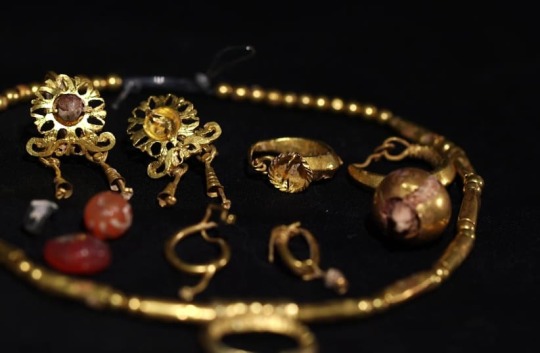
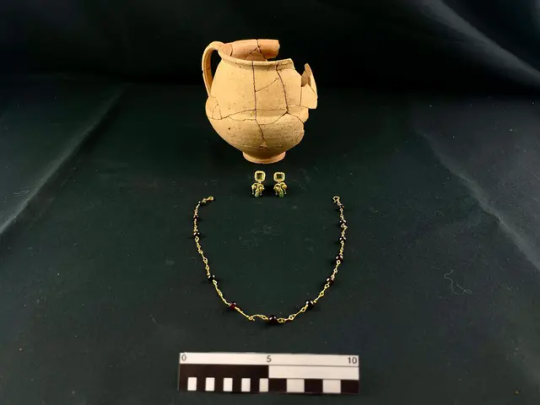
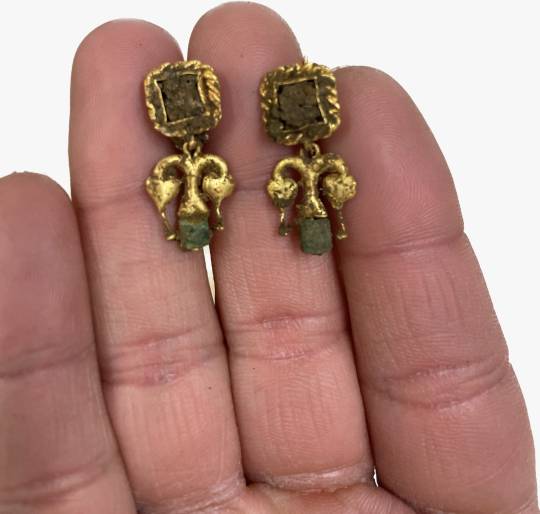
Silver rings with amber and engraved initials, precious stones, terracotta pottery, coins, shiny glasses, amulets and even items of clothing were found alongside the golden necklaces and earrings.
“We found several skeletons still wearing their expensive stockings and shoes,” Emanuele Giannini, lead excavation archaeologist at the site said. “All these riches, and the fact that the bones show no sign of stress or physical labor, (leads us to believe) these weren’t local farmers, but upper-crust members of Roman families coming from cities.”
Giannini said techniques of “pre-emptive archaeology” such as field surveys and trial trenches were used to identify potentially ancient constructions below ground.
“We did have a faint idea that some treasure could lie there, as historical sources mentioned the location of a postal station for travelers near the site,” explained Giannini. “Many Romans would stop (here) for the night to eat and rest, but the magnitude of the discovery is unmatched.”


The diversity of funerary objects laid near the remains, and the luxurious designs and linings inside the tombs, have led archaeologists to believe that the occupants wanted to recreate heavenly spaces similar to their earthly homes. The interior of many tombs originally featured elaborate cloth linings, or were surrounded and covered by tiles or terracotta pieces like little houses.
Giannini said another astounding aspect is that most of the discovered tombs were communal — built for at least two occupants who likely shared a family link. A few skeletons were found wrapped around each other.
“Building tombs for entire family nuclei is a typical ancient Roman trait,” he said, “but these are outstanding in their inner decor, which shows wealth and status.”
The shallow tombs were found just 20 inches below the surface — almost popping out of the grass — yet nobody had ever noticed anything peculiar.
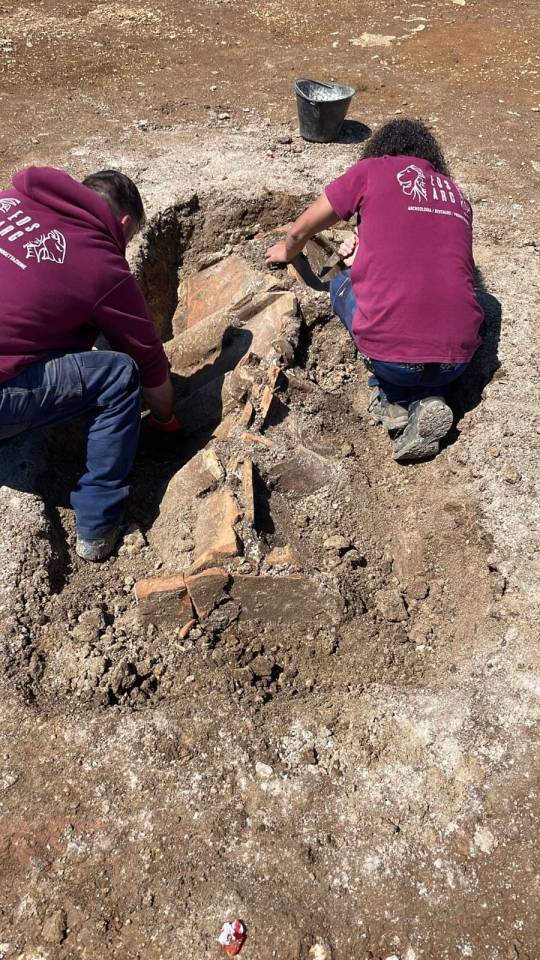


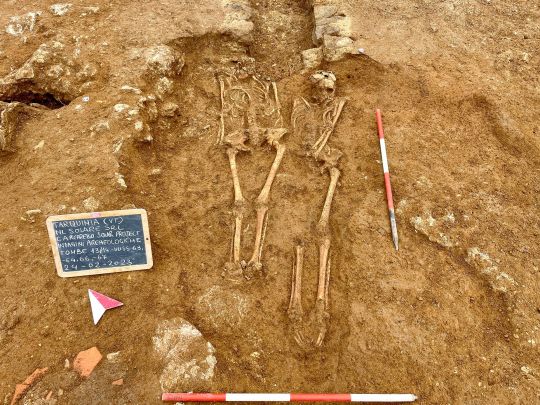
The site’s unique state of preservation has been attributed to the fact that “huge limestone blocks that stick out of the ground (made) ploughing, seeding and modern farming impossible in the area,” said Giannini. “It has remained untouched (for) centuries.”
Findings from the dig, which started in 2022, are being preserved as they’re found and many are going on show at the castle of Santa Severa in the coastal town of Santa Marinella. The skeletons however, are being analyzed to determine their origins and will not be put on display until forensic tests have been carried out.
Whatever their genesis, authorities are certain more hidden wonders will come to light as digs for the solar park move to another nearby site.
“We are excavating a huge rural area to redevelop the land and are balancing the need to avoid ruining such unique wonders with the goal of boosting clean energy production,” Margherita Eichberg, art heritage superintendent of the provinces of Viterbo and southern Etruria for Italy’s Culture Ministry said. The area where the necropolis has been discovered will not form part of the solar park and will be cordoned off for safety reasons, without public access.
“This is the fascination and beauty of Italy: Each time there’s a dig, incredible wonders from the past come out of the ground which need to be preserved.”
By Silvia Marchetti.

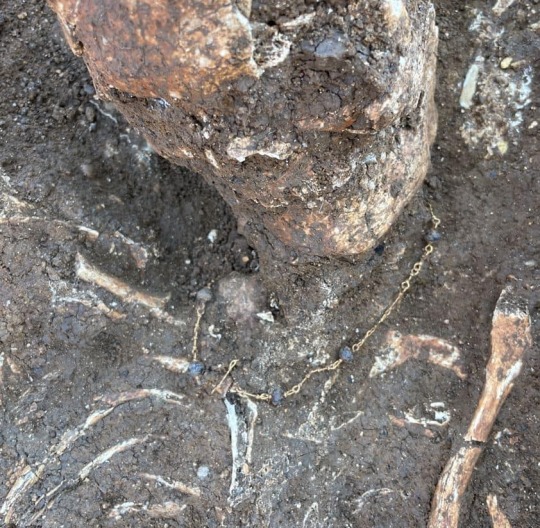
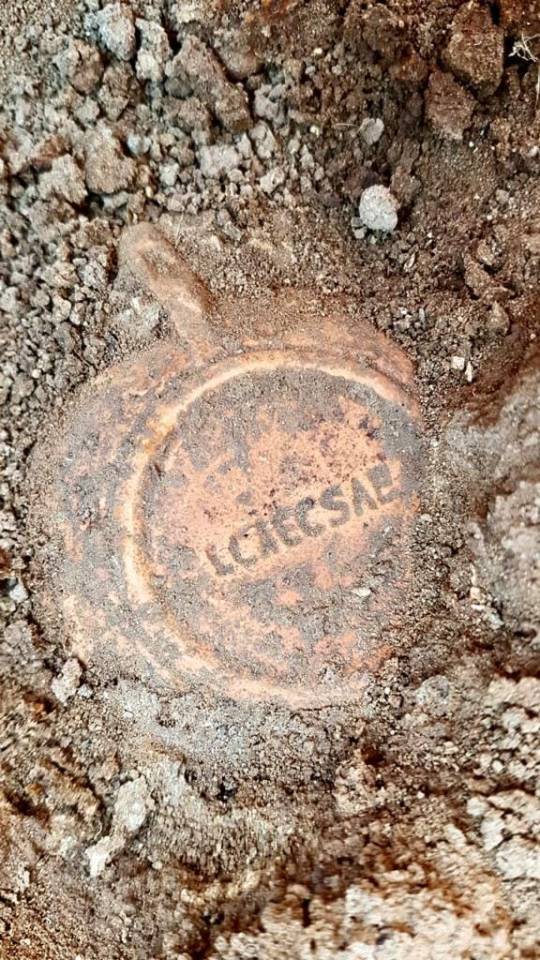


#Ancient Roman Elite Necropolis Discovered in Italy#ancient city of Tarquinia#ancient graves#ancient tombs#funeral goods#gold#silver#ancient artifacts#archeology#archeolgst#history#history news#ancient history#ancient culture#ancient civilizations#roman history#roman empire#roman art
74 notes
·
View notes